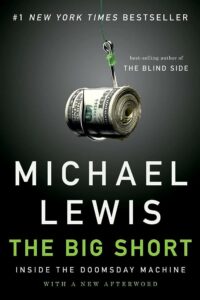
Introduction
In the wake of the global financial crisis of 2007-2008, a wave of books, movies, and documentaries emerged, attempting to dissect the complex factors that led to the catastrophic collapse of financial markets. Among them, Michael Lewis’s “The Big Short: Inside the Doomsday Machine” stands out as a brilliant narrative that peels back the layers of the financial world, revealing the shocking truths and personalities behind the crisis. Published in 2010, this book provides a gripping account of the events that led to the meltdown, the individuals who saw it coming, and the shocking realization that the very system meant to safeguard our financial well-being was fundamentally flawed.
Synopsis
“The Big Short” is not your typical finance book filled with dry data and impenetrable jargon. Instead, Michael Lewis crafts a compelling narrative that reads like a thriller. The book follows the lives of several key players who predicted the housing market bubble and made a fortune by betting against it. These individuals include Dr. Michael Burry, an eccentric hedge fund manager; Steve Eisman, a sharp-witted investor; and a group of traders at Deutsche Bank led by Greg Lippmann. Through their perspectives and experiences, Lewis takes readers on a rollercoaster ride through the labyrinthine world of Wall Street.
The Anatomy of a Crisis
One of the book’s strengths is its ability to break down complex financial concepts into digestible pieces for the lay reader. Lewis provides clear explanations of collateralized debt obligations (CDOs), credit default swaps (CDSs), and subprime mortgages, making it accessible to those without a background in finance. He meticulously unravels the financial products that contributed to the crisis, explaining how they were created, rated, and sold, often with a complete disregard for the underlying risks.
The Eccentric Heroes
Michael Lewis masterfully captures the eccentricities and idiosyncrasies of the individuals who saw the impending crisis and bet against the market. Dr. Michael Burry, with his unconventional personality and keen analytical skills, becomes a central figure. His relentless research and insistence on doing things his way make him a fascinating character. Similarly, Steve Eisman’s acerbic wit and blunt assessments of the financial industry provide a much-needed dose of skepticism in a world blinded by greed and complacency.
The Human Cost
While “The Big Short” is undoubtedly a gripping tale of financial intrigue, it doesn’t lose sight of the human aspect of the crisis. Lewis portrays the devastating consequences of the financial meltdown on ordinary people who lost their homes and livelihoods. The book serves as a stark reminder that behind every financial instrument and market maneuver are real lives affected by the decisions of those in power.
The Aftermath
As “The Big Short” unfolds, readers witness the gradual realization within the financial industry that the system was broken beyond repair. The aftermath of the crisis saw congressional hearings, regulatory reforms, and a broader public questioning of the ethics and accountability of Wall Street. Lewis paints a vivid picture of the chaos and reckoning that followed the meltdown, leaving readers with a sobering understanding of the fragility of our financial institutions.
Conclusion
“The Big Short” by Michael Lewis is a gripping and accessible account of the financial meltdown that shook the world in 2008. Through the lens of fascinating characters and a storytelling style that keeps readers on the edge of their seats, Lewis dissects the complex financial instruments and decisions that led to the crisis. In doing so, he offers a critical examination of the flaws within the financial system and a reminder of the human toll of Wall Street’s excesses. A decade after its publication, “The Big Short” remains a relevant and essential read for anyone seeking to understand the intricacies of the modern financial world and the dangers that lie beneath its surface.